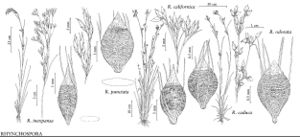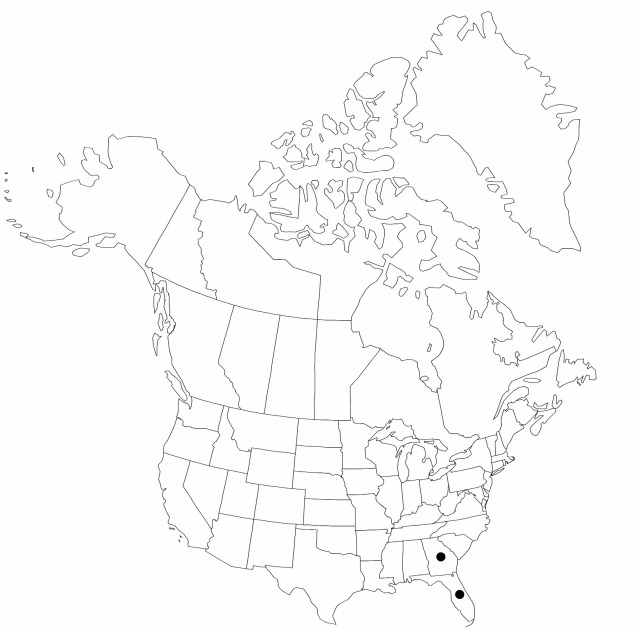Difference between revisions of "Rhynchospora punctata"
Sketch Bot. S. Carolina 1: 60. 1816.
FNA>Volume Importer |
imported>Volume Importer |
||
| (6 intermediate revisions by 2 users not shown) | |||
| Line 6: | Line 6: | ||
|place=1: 60. 1816 | |place=1: 60. 1816 | ||
|year=1816 | |year=1816 | ||
| + | }} | ||
| + | |special_status={{Treatment/ID/Special_status | ||
| + | |code=F | ||
| + | |label=Illustrated | ||
| + | }}{{Treatment/ID/Special_status | ||
| + | |code=E | ||
| + | |label=Endemic | ||
| + | }}{{Treatment/ID/Special_status | ||
| + | |code=C | ||
| + | |label=Conservation concern | ||
}} | }} | ||
|basionyms= | |basionyms= | ||
| Line 11: | Line 21: | ||
|name=Phaeocephalum punctatum | |name=Phaeocephalum punctatum | ||
|authority=(Elliott) House | |authority=(Elliott) House | ||
| + | |rank=species | ||
}} | }} | ||
|hierarchy=Cyperaceae;Rhynchospora;Rhynchospora punctata | |hierarchy=Cyperaceae;Rhynchospora;Rhynchospora punctata | ||
| Line 27: | Line 38: | ||
|distribution=Fla.;Ga. | |distribution=Fla.;Ga. | ||
|discussion=<p>Of conservation concern.</p><!-- | |discussion=<p>Of conservation concern.</p><!-- | ||
| − | --><p>Rhynchospora punctata is similar to R. harveyi and R. compressa in its preference for more upland sites. Like R. compressa, R. punctata often has many imperfectly formed fruits, suggestive of hybrid origin.</p> | + | --><p><i>Rhynchospora punctata</i> is similar to <i>R. harveyi</i> and <i>R. compressa</i> in its preference for more upland sites. Like <i>R. compressa</i>, <i>R. punctata</i> often has many imperfectly formed fruits, suggestive of hybrid origin.</p> |
|tables= | |tables= | ||
|references= | |references= | ||
| Line 36: | Line 47: | ||
-->{{#Taxon: | -->{{#Taxon: | ||
name=Rhynchospora punctata | name=Rhynchospora punctata | ||
| − | |||
|authority=Elliott | |authority=Elliott | ||
|rank=species | |rank=species | ||
| Line 50: | Line 60: | ||
|publication title=Sketch Bot. S. Carolina | |publication title=Sketch Bot. S. Carolina | ||
|publication year=1816 | |publication year=1816 | ||
| − | |special status= | + | |special status=Illustrated;Endemic;Conservation concern |
| − | |source xml=https:// | + | |source xml=https://bitbucket.org/aafc-mbb/fna-data-curation/src/2e0870ddd59836b60bcf96646a41e87ea5a5943a/coarse_grained_fna_xml/V23/V23_388.xml |
|genus=Rhynchospora | |genus=Rhynchospora | ||
|species=Rhynchospora punctata | |species=Rhynchospora punctata | ||
Latest revision as of 20:40, 5 November 2020
Plants perennial, cespitose, 60–80 cm; rhizomes absent. Culms erect or ascending, leafy, trigonous, slender. Leaves all exceeded by culm; basal blades spreading, often curled, distal longer, all proximally flat, 3–5 mm wide, apex trigonous, subulately tapering. Inflorescences: clusters 3–5, proximalmost distant, longest pedunculate, fascicles broadly turbinate to hemispheric; leafy bracts of distal groups mostly exceeded by inflorescence. Spikelets lanceovoid, (3.5–)4–5 mm; fertile scales broadly ovate to ± orbiculate, cupulate, rounded, 3 mm, apex apiculate to cuspidate, midrib excurrent. Flowers: perianth bristles 6, overtopping tubercle (or at least its base), antrorsely barbellate. Fruits 1–3 per spikelet, 2.3–3 mm; body brown, strongly compressed proximally, biconvex distally, broadly obovoid, 1.8–2.2 × 1.5 mm; surfaces strongly transversely rugose, intervals with rows of narrow, vertical alveolae; tubercle triangular, flat, 1 mm, base lunate, capping fruit apex, apiculate.
Phenology: Fruiting spring–summer.
Habitat: Sands and peats of savannas, open pine-wiregrass flats, sandhills bogs ecotones
Elevation: 0–200 m
Discussion
Of conservation concern.
Rhynchospora punctata is similar to R. harveyi and R. compressa in its preference for more upland sites. Like R. compressa, R. punctata often has many imperfectly formed fruits, suggestive of hybrid origin.
Selected References
None.

